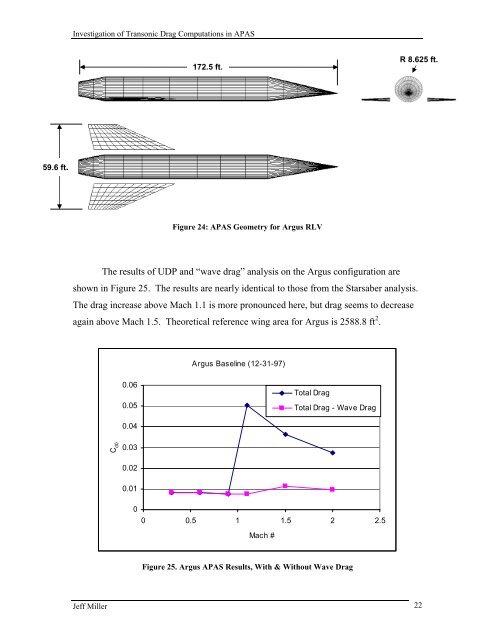Investigation of Transonic Drag Computations in Aerodynamic ...
Investigation of Transonic Drag Computations in Aerodynamic ...
Investigation of Transonic Drag Computations in Aerodynamic ...
Create successful ePaper yourself
Turn your PDF publications into a flip-book with our unique Google optimized e-Paper software.
<strong>Investigation</strong> <strong>of</strong> <strong>Transonic</strong> <strong>Drag</strong> <strong>Computations</strong> <strong>in</strong> APAS<br />
172.5 ft.<br />
R 8.625 ft.<br />
59.6 ft.<br />
Figure 24: APAS Geometry for Argus RLV<br />
The results <strong>of</strong> UDP and “wave drag” analysis on the Argus configuration are<br />
shown <strong>in</strong> Figure 25. The results are nearly identical to those from the Starsaber analysis.<br />
The drag <strong>in</strong>crease above Mach 1.1 is more pronounced here, but drag seems to decrease<br />
aga<strong>in</strong> above Mach 1.5. Theoretical reference w<strong>in</strong>g area for Argus is 2588.8 ft 2 .<br />
Argus Basel<strong>in</strong>e (12-31-97)<br />
0.06<br />
0.05<br />
Total <strong>Drag</strong><br />
Total <strong>Drag</strong> - Wave <strong>Drag</strong><br />
0.04<br />
C d0<br />
0.03<br />
0.02<br />
0.01<br />
0<br />
0 0.5 1 1.5 2 2.5<br />
Mach #<br />
Figure 25. Argus APAS Results, With & Without Wave <strong>Drag</strong><br />
Jeff Miller 22
















